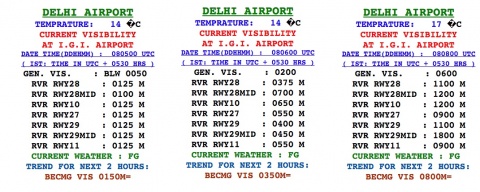-
Prasanto K Roy
08th Jan 2016
After a most-summer-like December, Delhi saw its first real winter fog today, a month late, on January 8.
Not unexpectedly, well over 100 flights departing from Delhi’s IGI Airport were badly delayed, stuck in the take-off queue for three to four hours. At least three incoming flights were diverted.
How bad was the fog? Here at my Gurgaon apartment, visibility was less than 50 meters at 8 am; at Delhi airport, 15 km away as the crow flies, runway visual range (RVR) was under 75 meters across its three runways at the time. In an hour it improved to 100 meters, then 125 meters by 10 am, and finally to over 375 meters by noon (see image below).

The visibility (RVR, or Runway Visual Range) at Delhi airport on January 8, at just after 10 am, 11 am and 1 pm (life feed here)
So how good is the tech at Delhi airport? Well, two of IGI’s three runways, 10/28 and 11/29, have Cat IIIB instrument landing system (ILS), among the most advanced in the world. The third runway, 9/27, has the much older Cat I.
Worldwide, runways are numbered from 01 and 36, based on their orientation from north. So a runway pointing dead east would be runway 9 (i.e. 90 degrees from north) in the west to east direction, and runway 27 (270 degrees from north) in the opposite, east to west. And it would called runway 9/27.
Delhi, in addition, has an RVR system called Dristhi, with 10 devices across the three runways, which help it track RVR and give inputs to the ILS. This system was indigenously developed by CSIR, India’s Center for Scientific and Industrial Research.
There are at least three major reasons so many departing flights were delayed in Delhi today, while most arriving flights landed with minor delays. One, incoming flights have absolute priority at airports: departing flights on the ground can wait. Two, not all aircraft are Cat IIIB ready and not all pilots Cat IIIB trained. Those have to wait till the fog clears. At least a third of the commanders and co-pilots flying in Indian skies are not Cat III certified.
But most important, Delhi airport was at between 50 and 100 meters visibility in the early morning hours. Good enough for landing, but not for take-off. Indian aviation rules allow Cat IIIB operations allow at 50 meter runway visibility (RVR), but need at least 125 meters for take-off. Why?
Landing a modern airliner is a cinch (for a trained pilot!). Most aircraft use autopilot to land--a system called Autoland, mandatory with Cat IIIB ILS operations. Using Autoland, aircraft can land in Delhi as long as the RVR is above 50m. Keep in mind that they’re touching down at over 250 km per hour, at which speed 50 meters is crossed in a half second—so visually, that’s like landing blind. But the on-board instruments are tracking the ILS radio beacons.
Take-offs, though, are manual. There are many decisions required, including the need to abort takeoff if something’s spotted on the runway: a jeep, aircraft, or, amazingly, in India, even an animal. Things can go wrong on takeoff, and it is difficult for an autopilot to be aware of quickly changing winds and weather, unusual noises, or runway conditions. There are also air traffic control instructions, including possible abort instructions, conveyed to pilots.
The need for pilots to look down at instruments and then look up at the runway, refocusing their eyes, adds another few moments to response time. The most modern airliners, such as the Boeing 787 Dreamliner, use head-up displays, which show all vital information on a transparent screen in front of the pilot’s eyes. A Dreamliner pilot tells me that this reduces the buffer needed to 75 meters RVR, as accepted in the West; but India’s aviation authority hasn’t agreed to that yet, and has kept the minimum RVR at 125 meters for takeoff for all aircraft.
It’s not just the tech in the aircraft: the pilot has to be trained and certified too. Not all the airlines have pilots certified for Cat IIIB operations.
What’s next in tech? Well, there’s Cat IIIC, which allows zero-visibility landings. While that’s theoretically possible with Cat IIIB too, landing in actual zero-visibility conditions is impractical, because the aircraft would need guidance to taxi as well (just as you can’t drive in true zero visibility).
But things could improve even with current tech, with more pervasive training--getting all pilots who fly to and from Delhi to be Cat III certified, as the DGCA has been demanding, but not enforcing.
Prasanto K Roy (twitter: @prasanto) is chief editor of Trivone’s publications, including TechTree and CXOtoday.
With So Much Tech, Why Does Fog Disrupt Flights? | TechTree.com
With So Much Tech, Why Does Fog Disrupt Flights?
This winter’s first real fog saw over 100 badly-delayed flights in Delhi. Why doesn’t tech help? Well, it did, actually
News Corner
- DRIFE Begins Operations in Namma Bengaluru
- Sevenaire launches ‘NEPTUNE’ – 24W Portable Speaker with RGB LED Lights
- Inbase launches ‘Urban Q1 Pro’ TWS Earbuds with Smart Touch control in India
- Airtel announces Rs 6000 cashback on purchase of smartphones from leading brands
- 78% of Indians are saving to spend during the festive season and 72% will splurge on gadgets & electronics
- 5 Tips For Buying A TV This Festive Season
- Facebook launches its largest creator education program in India
- 5 educational tech toys for young and aspiring engineers
- Mid-range smartphones emerge as customer favourites this festive season, reveals Amazon survey
- COLORFUL Launches Onebot M24A1 AIO PC for Professionals







TECHTREE